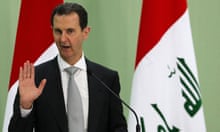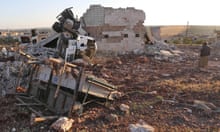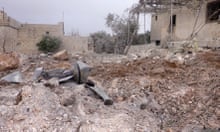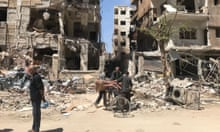The first sign of a change came on Wednesday afternoon, when Donald Trump appeared in the White House rose garden. He was giving a news conference. The previous day a rocket had fallen on the rebel-held Syrian town of Khan Sheikhun.
At first this appeared to be another airstrike by the Syrian regime of Bashar al-Assad on an area in Idlib province long controlled by opposition forces. It was, seemingly, a routine act of barbarism. An airstrike was unremarkable in Syria’s grinding six-year-long civil war.
And yet this one was different. The missile allegedly contained the deadly nerve agent sarin. Within minutes, the northern part of the town had been engulfed with poisonous gas. At least 70 people were killed: men, women, children.
The first rescuers came on a scene that Trump described as “horrific”. Children lay on the ground, foaming at the mouths, their lips going blue, dropping in and out of consciousness. Inside houses, teams found infants dead in their beds. Near them were the bodies of victims that had collapsed as they tried to flee.
“Wherever you looked there were dead human beings,” said Abu al-Baraa, who lives nearby.
The images had a profound effect on the US president.
Previously Trump’s administration had indicated that its priorities in Syria were fighting Isis and Islamist terrorism. There was no mention of removing Assad from power: a key, long-unfulfilled demand from the US’s European allies. And then there was Russia, Assad’s chief backer, and a power that from 2015 had tilted the war in the regime’s favour.
A few days earlier Sean Spicer, the White House press secretary, said it was necessary to accept “political reality” in Syria. Up to this point Trump had been a longstanding sceptic of US military action. Back in 2013 he tweeted that the president, Barack Obama, should refrain from intervening and “stay away and fix a broken US”. The “rebels”, he added, were “just as bad as the Syrian regime”.
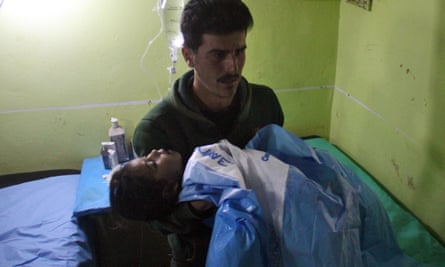
Now, though, Trump was talking about his new “flexibility”. “I will tell you that attack on children yesterday had a big impact on me – big impact,” Trump told reporters in the rose garden. “My attitude toward Syria and Assad has changed very much … You’re now talking about a whole different level.”
This was the first alleged attack by the regime using sarin since 2013, when the nerve agent was dumped on an opposition-controlled area of Damascus. More than 1,000 people perished. This latest attack – after a deal brokered by Russia, in which Assad agreed to give up his chemical weapons stockpile – “crossed a lot of lines for me”, Trump said.
He went on: “When you kill innocent children, innocent babies, babies, little babies, with a chemical gas that is so lethal – people were shocked to hear what gas it was. That crosses many, many lines, beyond a red line, many, many lines.”
The president, in office for just 77 days, declined to say whether he would now contemplate the previously unthinkable: a US strike against Syrian military targets. This would go beyond anything done by the Obama administration, which came close to an attack in 2013 but then blinked. Trump had criticised Obama for vacillation and weakness. Would he act differently?
Within 24 hours Trump’s flexibility had translated into direct action. At the Pentagon senior military officials began drafting policy options. They included both extensive and less far-reaching strikes against Syrian regime targets. There was diplomatic movement too: the secretary of state, Rex Tillerson, signalled that the White House was considering a decisive response.
On Wednesday evening Trump’s core national security team held discussions on Syria which went on until the early morning. There were conversations involving Trump’s national security adviser, HR McMaster – a more conventional figure than his shortlived predecessor, Mike Flynn – plus the defence secretary, Jim Mattis. Tillerson was looped in.
Behind the scenes, US intelligence agencies sought to verify that Syrian warplanes had indeed carried out the Khan Sheikhun attack. Moscow claimed that there was no objective evidence this was the case. Instead, the Kremlin offered a different scenario: that Syrian bombs had hit a chemical weapons dump used by the rebels. Might this be true?
On Thursday in Washington the president met his National Security Council. The intelligence assessment was clear: this was a regime attack launched from a Syrian government airbase near the town of Homs. Officials presented Trump with three options. According to the New York Times, the president asked numerous questions. He told officials to focus on two plans for action.
Trump’s week was supposed to have played out differently, its big setpiece a meeting with the Chinese leader, Xi Jinping. The summit at the president’s Mar-a-Lago resort was going ahead as planned. Instead of talk on trade and North Korea, the White House’s focus was elsewhere, on Syria and the possibility of imminent US retaliation.
The president flew to Palm Beach, Florida, on Air Force One. Sitting in the back of the plane were White House reporters. They passed the time watching the in-flight movie: Rogue One: a Star Wars Story. This was a tale in which – unlike in real life – the good and the bad guys are sharply delineated. Suddenly, Trump poked his head into the cabin.
Speaking next to an onscreen backdrop of Darth Vader, the president described Assad’s actions as a crime – “terrible” and “truly egregious”.
“It shouldn’t have happened,” he said. “It shouldn’t have been allowed to happen.” The president said he hadn’t talked to Vladimir Putin, Assad’s international partner, but might do so in the future.
It was a surreal trip. Spicer gave interviews as well, speaking next to an action shot of stormtroopers bursting from a silo. There was turbulence. The press secretary spilled coffee over himself.
After weeks in which his administration had seemed consumed by leaks, in fighting, drift and ineptitude, Trump was moving at speed. At Mar-a-Lago he convened a meeting with his senior national security officials – some at the resort, others patched in from Washington.
It ended with Trump authorising military action and the first US attack on Syrian regime forces since the civil war began in March 2011.
The president had gone for the more cautious of the two plans presented to him: a limited and largely symbolic strike on a Syrian airbase. The Pentagon informed Russian forces that the bombing mission was going ahead. It seems probable Moscow would have passed the warning to Damascus. The US’s key western allies including the UK were briefed.
Military goals agreed, it was time for dinner. The Chinese president sat next to Trump and his wife, Melania. Close by were the president’s daughter and adviser Ivanka and her husband – just back from Iraq – Jared Kushner. Opposite Xi was the White House chief of staff, Reince Priebus. Near the end of the table was Steve Bannon, recently demoted from the war-making National Security Council. On the menu was New York strip steak and California wine.
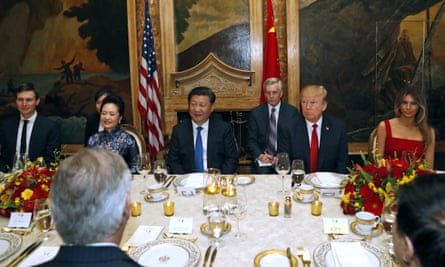
By the time the Chinese delegation exited into a muggy Florida night the airstrikes had already happened. At about 8.40pm Eastern time (0140 GMT) two US destroyers stationed in the eastern Mediterranean – Porter and Ross – unleashed 59 Tomahawk missiles. The attack lasted for three or four minutes. Pentagon video footage showed the missiles roaring into a jet-black sky.
They landed on the Sharyat airbase, south-east of Homs. This was a relatively modest military facility: two runways, a dozen hangars and a fuel depot. Nearby were support buildings. The missiles caused extensive damage. Ambulances and fire engines scrambled into action. Seven people were killed, Syrian state news agencies reported.
The White House directly linked the base with Tuesday’s murderous attack in Idlib. It suggested the planes that dropped the sarin had come from here, with some sources suggesting that Russian soldiers were stationed at the same base. (Other eyewitnesses said the Russians left in early 2016 with the base mainly used by Syrian and Iranian military officers.) Briefing notes passed to the Washington Post said there was a “high degree of confidence” Assad was behind the attacks.
At Mar-a-Lago on Thursday night Trump explained his surprise assault to the world. He said Assad – “a dictator” – had “choked out the lives of innocent men, women and children.” “It was a slow and brutal death for so many. Even beautiful babies were cruelly murdered in this very barbaric attack,” he declared, adding: “No child of God should ever suffer such horror.”
It was an effective speech but one that left multiple questions unanswered. Was Thursday’s strike a prelude to further US military engagement in Syria’s intractable conflict or a one-off? What policy was the US government offering to end Syria’s war? And what of the consequences, both for the region and for the US’s uncertain relations with Russia?
Trump’s attack marked a clear break from the policy of the previous government. Obama had consulted allies. He preferred multilateral talks. His successor, meanwhile, had taken swift unilateral action, seemingly without consulting anybody internationally. Trump had bypassed Congress. He had ignored the United Nations.
His officials argued that there was a clear legal basis for attacking Syria. They said that the use of chemical weapons threatened the stability of the Middle East – and, therefore, the US’s national interest. The strike, moreover, protected a defenceless civilian population from humanitarian atrocity.
For the White House Thursday brought obvious dividends. After a chaotic period, in which the administration had been dogged by its apparent ties to the Kremlin, the news agenda had decisively flipped. For months, Trump had been unable to shake off accusations that he had colluded with Putin before the US election.
Now the president was acting publicly against Russia’s strategic interests. Or at least he appeared to be.
Some of Trump’s sharpest Republican critics on Russia – senators John McCain and Lindsey Graham – praised his action. Hours before the strike Hillary Clinton said she backed intervening. Trump’s opinion poll ratings are at historic lows. One imagines they will now creep upwards.
Western countries including the UK, Canada, Australia and Israel offered support. So did other useful allies including Turkey and Jordan. Nato’s secretary general, Jens Stoltenberg, said Assad bore full responsibility for what happened. Even Tim Farron, the Liberal Democrat leader, found himself in the unusual position of endorsing Trump, a fan of Brexit.
From Moscow there was predictable condemnation, plus a promise to strengthen Syria’s air defences to prevent future US attacks. Putin’s press spokesman Dmitry Peskov talked of “aggression against a sovereign nation” on a “made-up pretext”.
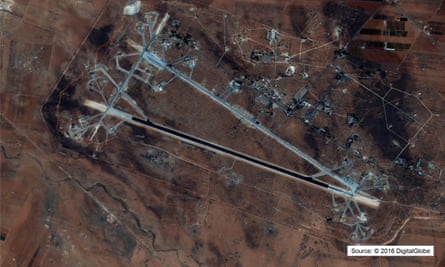
But Kremlin figures were careful not to trash Trump directly. They suggested that US spy agencies had bounced Trump into action by feeding him fake intelligence – a conspiracy theory aired by the pro-Kremlin political analyst Sergei Markov.
One immediate consequence was that Moscow said it was ending a communications channel to prevent US and Russian pilots from colliding in the skies above Syria. The “deconfliction line” had worked since autumn 2015, when Russia began bombing Syrian rebels.
On the ground Syrian opposition fighters and officials expressed general satisfaction that the regime had been punished for its chemical attack. They were sceptical that the Trump administration cared deeply about the plight of Syrians. They said further US attacks would be needed against military infrastructure before lethal bombing raids would stop.
As always in Syria, the immediate losers were not the country’s leaders but its hapless civilians. At midday on Friday warplanes returned to the skies above Khan Sheikhun. Syrian or Russian jets – it wasn’t clear which – carried out another bombing raid, witnesses said.
The bombs landed in the same part of town where Tuesday’s sarin missile had struck earlier, leaving behind a small, blackened crater.
It wasn’t clear if anybody was killed. But the message was clear.
Despite Trump’s martial display, and his handbrake shift from isolation to intervention, the regime was still fighting. Syria’s war was far from over.
- This article was amended on 10 April 2017 to remove a reference to the chemical attack as giving off a choking, yellow fog.
